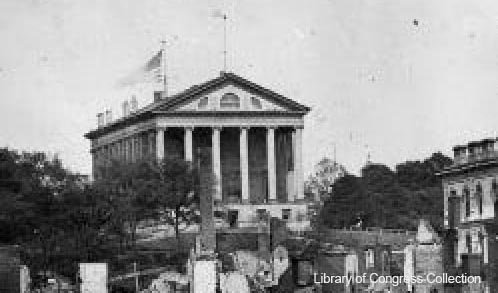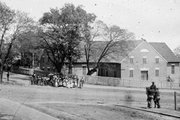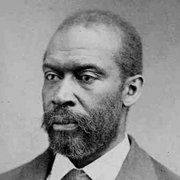When Freedom Came, Part 1
Elvatrice Belsches | 4/2/2015, 12:03 a.m. | Updated on 4/2/2015, 12:03 a.m.

The Free Press presents a three-part installment chronicling the African-American experience during the liberation of Richmond in April 1865 and the final days of the Civil War. This is Part One.
The evacuation of Richmond had been rumored for weeks.
It was late March 1865, and Richmond, the capital of the Confederate States of America, was suffering from a lack of food and fuel, as well as fatigue brought on by a Civil War that had taken its toll over the previous four years.
The city, whose pre-war population had swelled from roughly 38,000 to more than 100,000 with an influx of refugees fleeing from the fighting, was still working to support a Confederate army that had been under siege by federal Union troops for the last nine months just 23 miles south in Petersburg.
If Union forces could capture Petersburg, then Richmond would fall soon after. Capturing the Confederate capital essentially would bring an end to the war and to a death toll nearing 700,000 by recent estimates.
It also would mean a fateful and fitting end to a way of life that for more than two centuries had depended on the free labor of black people.
Slavery fueled Richmond’s economy. The work of enslaved and free black people in households and as laborers, stevedores and artisans sustained and grew the city’s tobacco industry, ironworks, mills and other commerce.
Richmond and its many merchants also prospered from the export of slaves. Thousands of black people were bought and sold from the dozens of slave auction houses in Shockoe Bottom, making Richmond one of the largest sources of enslaved Africans on the East Coast from 1830 to 1860.
By 1865, as Richmond’s population exploded, so, too, the city’s black population grew from the roughly 12,000 enslaved and 2,600 free black people counted in the 1860 Census. So it was no wonder that news had traveled to Richmond and circulated widely among the city’s black population that freedom might be near.
“The evacuation of Richmond for some weeks has frequently been announced in The Press as being actually in progress. It is now credited in the best military circles to such an extent as to make a disposition of the forces to meet such a contingency.
“The authorities obtain their information from scouts and reliable persons, which is to the effect that all cumbersome munitions of war and contraband property are being removed from the city. [Confederate Gen. Robert E. Lee] must either assault our works, and what is more difficult, defeat our armies, or vacate his stronghold, if he would save his hordes from immediate capture.” – Thomas Morris Chester March 28, 1865
Thomas Morris Chester, the only known black reporter to cover the war for a major daily newspaper, was traveling among black troops with the Army of the James under Brevet Maj. Gen. A.V. Kautz and Maj. Gen. J. Godfrey Weitzel. He chronicled for the Philadelphia Press many of the significant final events in this tumultuous period in American history.
Black people had long served in support capacities for the Union forces. And many black men, both free and slave, were conscripted, or pressed into service working for the Confederacy in building fortifications and working as hospital attendants, messengers, launderers, cooks and artisans.
However, as early as 1861, an ever-growing chorus pressed the need for black men to serve as soldiers for the Union.
“Once let the black man get upon his person the brass letters U.S., let him get an eagle on his button, and a musket on his shoulder and bullets in his pocket, there is no power on earth which can deny that he has earned the right to citizenship.”
Those words by abolitionist Frederick Douglass, himself a former slave, would prove prophetic. Upward of 180,000 black men served in uniform in the Union army, making up 10 percent of Union forces, according to the National Archives. Another 18,000 or so black men and women also served in the Union Navy.
In one battle in Henrico County alone, 14 black soldiers would be awarded the Medal of Honor. They were cited for heroism at the Battle of New Market Heights on Sept. 29, 1864.
All told, 25 African-Americans, including seven sailors, would be given the nation’s highest honor for bravery and gallantry during the Civil War, despite harsh conditions, deprivation, injustice and death.
About 40,000 black soldiers died in the war, with 30,000 succumbing to infection or disease.
“Out of eighty-three colored soldiers who were captured last July and confined to Danville, only five survived the barbarous treatment which has been perpetrated against them.
“One of the returned prisoners assures me that two of our colored soldiers, who were captured about last July, were taken into the woods by rebel officers, and placed as targets, where with their pistols they fired for their amusement and to improve their aim.” – Thomas Morris Chester Feb. 22, 1865
Eager to see the war come to a quick end, President Abraham Lincoln traveled with his wife and son by boat from Washington and arrived on March 24, 1865, at City Point, now Hopewell, to meet with Gen. Ulysses S. Grant and other top military advisers, 22 miles southeast of Richmond.
“Another event of yesterday which attracted considerable attention in this army was the arrival of President Lincoln, and his reviewing parts of the 24th and 25th Corps. Both white and colored troops looked well, and, if possible, marched better than on former occasions. It was a grand sight, and must have been a source of considerable satisfaction to his Excellency, Mrs. Lincoln, Miss Wells, and other ladies who accompanied the President to the front and witnessed the martial ceremonies.” – Thomas Morris Chester March 1865
In addition to viewing white and black troops and visiting wounded Union and Confederate soldiers in hospitals, President Lincoln traveled by train and horseback to the front lines around Petersburg to see the carnage firsthand.
Deprivation knew no color or boundaries. Civilians struggled for food, which was at a premium. Merchants charged exorbitant prices for basic items, such as bread, milk and flour. The uncertainty of war had become a heavy burden.
When Union troops forged a victory on April 1, 1865, at the Battle of Five Forks near Petersburg, cutting off road and rail supply lines for Confederate Gen. Robert E. Lee, the surrender of Petersburg and Richmond was imminent.
On the morning of April 2, 1865, Jefferson Davis, president of the Confederate States of America, sat worshipping at St. Paul’s Episcopal Church near the capitol when a messenger arrived with correspondence from Gen. Lee.
The message: Gen. Lee could not hold Confederate lines at Petersburg. Richmond must be evacuated.
The messenger: Richard Chiles, a black man of mixed parentage.
(Mr. Chiles, who is believed to have been in his 40s at the time, was the patriarch of what would become one of Richmond’s most venerable families of color.)
His son, John R. Chiles, born circa 1860, would become a wealthy businessman, civic leader and board member for the Mechanic’s Savings Bank started by black newspaperman John Mitchell. His twin, James Alexander Chiles, would graduate from Lincoln University and later, in 1889, the University of Michigan Law School. After practicing law briefly in Richmond, he would become a pioneering attorney in Kentucky. His daughter, Marietta L. Chiles, spent nearly 40 years teaching freedom’s first generation of black students in public schools in Richmond.)
(There is no relation to the Chiles’ Funeral Home family in Richmond’s East End.)
Mr. Davis left the church. Word spread quickly that Richmond was about to fall.
He ordered the evacuation of his government. The plan also called for any supplies that could benefit Union forces to be destroyed.
As Mr. Davis and his cabinet officers packed as much as possible and prepared to set out for Danville by train, chaos erupted in the streets.
Confederates set fire to arsenals, factories and supply warehouses. In accordance with military orders, hundreds of barrels of whiskey were broken open and flowed freely in the streets. Suddenly, Richmond was going up in flames. Fires raged out of control in the heart of the city around the capitol.
Mobs of people, both white and black, roamed the streets, pilfering from the newly opened storehouses all the items they previously were denied.
Homes and businesses alike were destroyed. The chaos was punctuated by earth-shattering explosions that killed several civilians.
Fleeing troops and civilians stuffed their pockets and bags with valuables and personal treasures.
“To Major General Godfrey Weitzel was assigned the duty of capturing Richmond … After midnight explosions began to occur so frequently as to confirm the evidence already in possession of the General-in-chief … The immense flames curling up throughout the rebel camps indicated that they were destroying all that could not be taken away.” – Thomas Morris Chester about overnight events of April 2, 1865, in Richmond
According to an eyewitness account, Robert Lumpkin, a Richmond slave trader and proprietor of Lumpkin’s Jail in Shockoe Bottom, tried unsuccessfully to protect his property and business investment — his slaves.
He quickly shackled together 50 enslaved men, women and children and headed to the train depot to flee to Danville.
He hoped to travel on the train with Mr. Davis and his cabinet. He was not allowed to board.
Scores of black people took refuge in First African Baptist Church at Broad and College streets, afraid that they would be used as human shields by Confederates when Union soldiers arrived. They stayed at the church, praying.
For them, and for thousands of others, the morning of April 3, 1865, would bring about a dawn like few others.
















